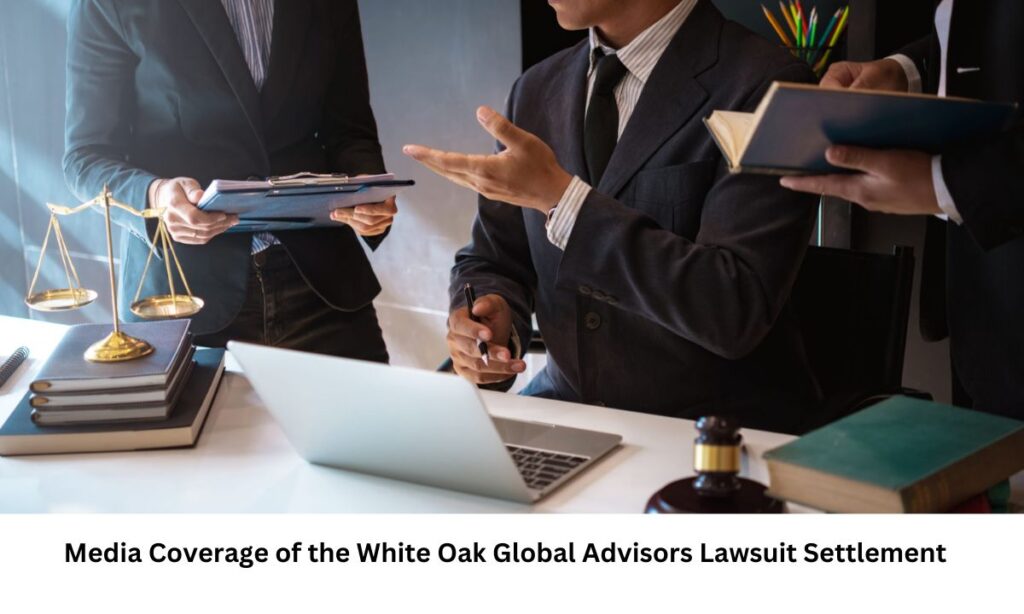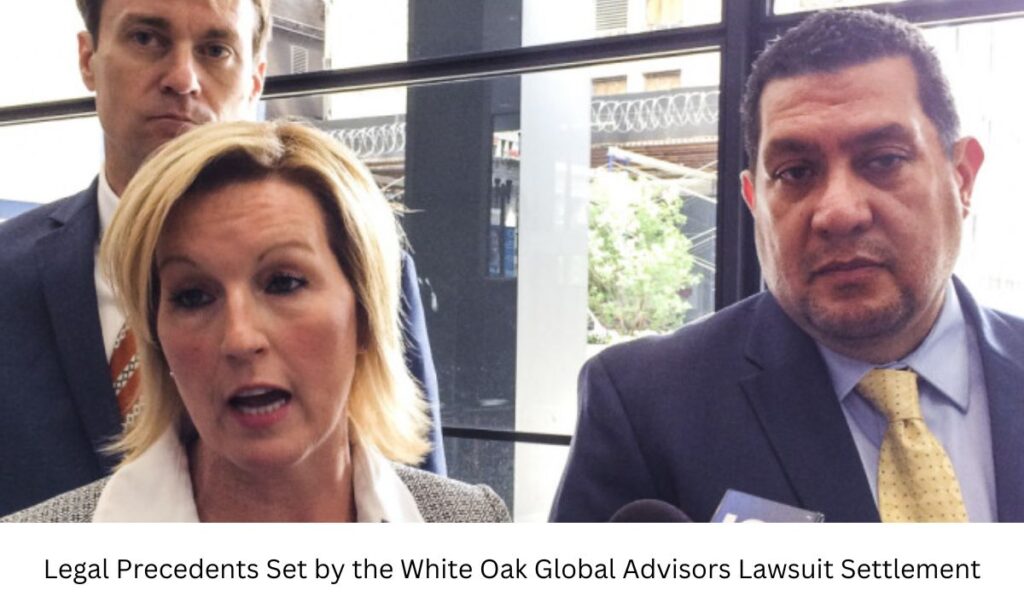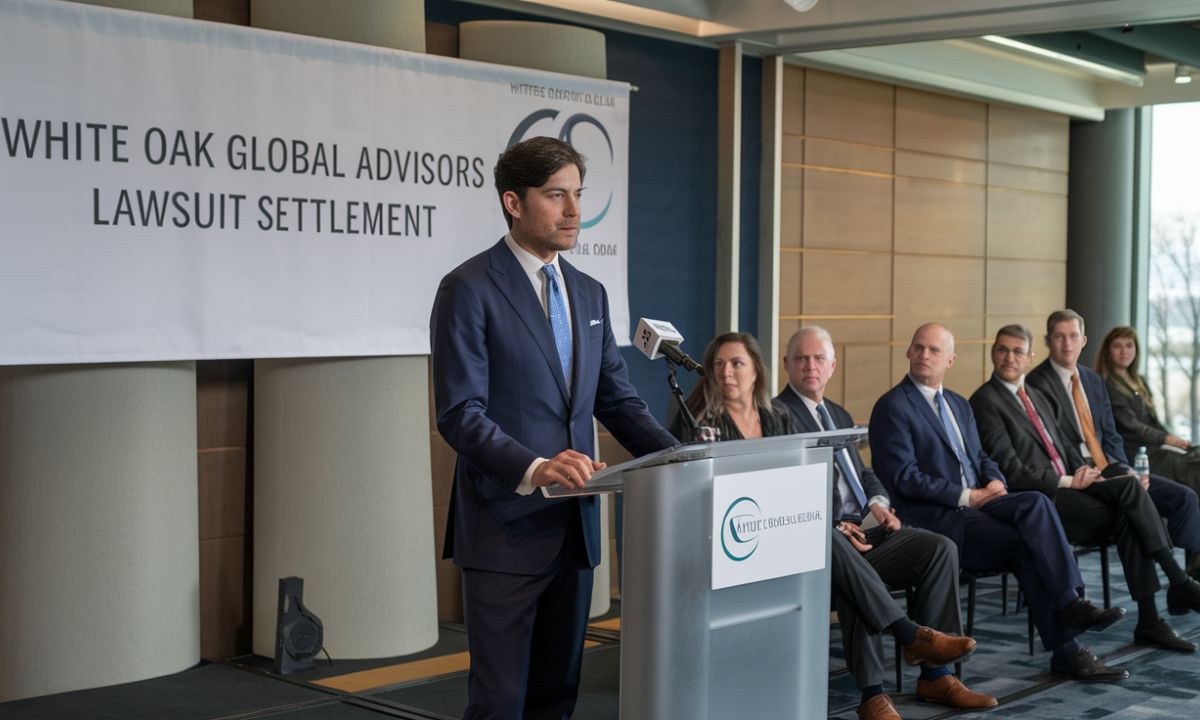The financial world has been abuzz with the recent conclusion of a major legal battle involving White Oak Global Advisors, a prominent player in the private credit and alternative investment sphere.
This landmark case has sent ripples through the industry, raising crucial questions about fiduciary duty, investment transparency, and regulatory oversight.
Let’s unpack the complexities of this settlement and explore its far-reaching implications for investors, financial firms, and the broader market landscape.
I. Background of the White Oak Global Advisors Lawsuit Settlement
A. Who is White Oak Global Advisors?
White Oak Global Advisors has long been a heavyweight in the alternative investment arena. Founded in 2007, the firm has built a reputation for innovative private credit solutions and boasted an impressive portfolio of assets under management.
Their client base spans institutional investors, high-net-worth individuals, and pension funds, all drawn to White Oak’s promise of attractive returns in a low-yield environment.
B. The Spark That Lit the Legal Fire
The trouble began brewing when a group of investors started noticing discrepancies between White Oak’s reported performance and their actual returns. What started as murmurs of discontent soon snowballed into a full-blown crisis of confidence.By early 2018, the situation had reached a boiling point, with investors demanding answers and threatening legal action.
C. The Crux of the Controversy
At the heart of the lawsuit were allegations of financial misconduct and breach of fiduciary duty. Investors claimed that White Oak had engaged in:
- Misrepresentation of investment risks
- Undisclosed conflicts of interest
- Improper valuation of assets
- Excessive fee structures
These accusations struck at the very core of the trust-based relationship between investment advisors and their clients, setting the stage for a legal showdown that would captivate the financial industry.
Read Also These: How Many Days Until Christmas 999999999999
II. Key Parties Involved in the White Oak Global Advisors Lawsuit Settlement

A. The Plaintiffs: Who Took White Oak to Court?
The lawsuit was spearheaded by a diverse group of investors, including:
- Large institutional funds
- Family offices
- Individual high-net-worth clients
Led by a consortium of heavyweight legal firms, the plaintiffs presented a united front, determined to hold White Oak accountable for alleged mismanagement and breaches of trust.
B. White Oak’s Defense Team
In response to the mounting legal pressure, White Oak assembled a formidable defense team. Drawing from top-tier law firms specializing in securities litigation, their strategy centered on:
- Challenging the plaintiffs’ interpretation of fiduciary duty
- Arguing for the complexity and inherent risks of alternative investments
- Highlighting their track record of overall positive performance
C. Regulatory Bodies and Their Role
The Securities and Exchange Commission (SEC) played a pivotal role in overseeing the case. As the primary watchdog for the U.S. financial markets, the SEC’s involvement lent additional gravity to the proceedings. Their focus was on:
- Ensuring fair disclosure practices
- Investigating potential violations of securities laws
- Safeguarding investor interests
Other regulatory bodies, including state-level agencies and industry self-regulatory organizations, also kept a close eye on the unfolding drama.
III. Legal Timeline of the White Oak Global Advisors Lawsuit Settlement
A. The Opening Salvo: Filing of the Lawsuit
The legal battle officially commenced in June 2018 when the investor group filed their complaint in the U.S. District Court for the Southern District of New York. The initial filing outlined a litany of grievances, setting the stage for a protracted legal struggle.
B. Key Milestones in the Legal Battle
| Date | Event | Significance |
| June 2018 | Lawsuit filed | Formal start of legal proceedings |
| September 2018 | White Oak’s motion to dismiss | Attempt to halt the case in its tracks |
| December 2018 | Court denies motion to dismiss | Green light for the case to proceed |
| March 2019 | Discovery phase begins | Unearthing of crucial evidence |
| August 2019 | Mediation talks initiated | First signs of potential settlement |
| October 2019 | Settlement agreement reached | Conclusion of active litigation |
C. The Road to Settlement
As the legal battle wore on, both sides began to feel the strain. The mounting legal costs, coupled with the potential for long-term reputational damage, pushed White Oak towards the negotiating table. After months of intense back-and-forth, facilitated by a court-appointed mediator, a settlement agreement was finally hammered out.
IV. Major Allegations in the White Oak Global Advisors Lawsuit Settlement

A. Breach of Fiduciary Duty: The Heart of the Matter
The cornerstone of the plaintiffs’ case was the alleged breach of fiduciary duty. In the world of investment management, fiduciary duty is sacrosanct.
It requires advisors to act in their clients’ best interests, placing those interests above their own. The plaintiffs argued that White Oak had fallen short of this standard in several ways:
- Prioritizing fees over performance: Accusations of structuring investments to maximize management fees rather than investor returns.
- Inadequate risk disclosure: Claims that White Oak downplayed or obscured the true risks associated with certain investments.
- Conflicts of interest: Allegations of favoring certain investors or investments for reasons other than merit.
B. Mismanagement of Funds: Where Did the Money Go?
Another key allegation centered on investment fund mismanagement. The plaintiffs painted a picture of a firm more concerned with aggressive growth than prudent stewardship of client assets.
Specific claims included:
- Overconcentration in high-risk investments
- Failure to adequately diversify portfolios
- Improper valuation of illiquid assets
These allegations struck at the heart of White Oak’s reputation as a sophisticated alternative investment manager.
More Post: The Inspiring Story of Kelly Baltazar: From Scandal to Recovery
C. Lack of Transparency: Keeping Investors in the Dark?
Transparency, or the lack thereof, emerged as a recurring theme in the lawsuit. Investors claimed that White Oak had:
- Provided misleading or incomplete performance reports
- Failed to disclose material information about investment strategies
- Obscured the true nature of fees and expenses
This alleged opacity, the plaintiffs argued, prevented them from making informed decisions about their investments and violated the principles of fair dealing.
V. Financial Implications of the White Oak Global Advisors Lawsuit Settlement
A. The Settlement Figure: Breaking Down the Numbers
After months of negotiations, White Oak Global Advisors agreed to a settlement totaling $175 million.
This figure, while substantial, represented a compromise between the initial damages sought by the plaintiffs and White Oak’s desire to limit its financial exposure.
The settlement broke down as follows:
- $150 million in direct compensation to affected investors
- $20 million earmarked for legal fees and administrative costs
- $5 million set aside for enhanced compliance measures
B. Impact on White Oak’s Bottom Line
The settlement dealt a significant blow to White Oak’s finances. Beyond the immediate cash outlay, the firm faced:
- A potential exodus of clients, eroding its asset base
- Increased insurance premiums due to the lawsuit
- Additional compliance costs to meet new regulatory scrutiny
Analysts estimated that the total financial impact, including indirect costs, could exceed $250 million over the next three years.
C. What It Means for Affected Investors
For the investors involved in the lawsuit, the settlement offered a measure of vindication and financial recompense.
However, the compensation structure meant that most would recover only a portion of their claimed losses. The payout schedule was designed as follows:
- An initial lump sum payment within 60 days of settlement approval
- Subsequent payments tied to the liquidation of certain White Oak assets
- A final distribution expected within 18-24 months
VI. How the White Oak Global Advisors Lawsuit Settlement Was Reached

A. The Art of Negotiation
The path to settlement was paved with intense negotiations, requiring skilled mediators and legal teams on both sides.
Key strategies employed included:
- Shuttle diplomacy: Mediators moving between parties to bridge gaps
- Financial modeling: Projecting various settlement scenarios and their impacts
- Face-saving measures: Crafting language that allowed both sides to claim partial victory
B. Sticking Points and Breakthroughs
Several issues threatened to derail the settlement talks:
- Admission of wrongdoing: White Oak initially resisted any language implying guilt
- Clawback provisions: Debates over whether certain bonuses should be returned
- Ongoing oversight: Disagreements about post-settlement monitoring of White Oak
The breakthrough came when both sides agreed to a “no-fault” settlement structure, coupled with enhanced compliance measures overseen by an independent monitor.
C. The Final Push: Sealing the Deal
In the end, it was a combination of factors that brought the settlement across the finish line:
- Mounting legal costs for both sides
- The looming threat of a potentially damaging trial
- Pressure from regulators for a swift resolution
The final agreement was reached during a marathon 48-hour negotiation session, with the last details ironed out in the early hours of the morning.
VII. Impact of the White Oak Global Advisors Lawsuit Settlement on Stakeholders
A. Investors: Winners or Losers?
For the plaintiffs, the settlement brought a mix of relief and frustration. While they secured significant compensation, many felt that the true cost of White Oak’s alleged mismanagement exceeded the settlement amount.
Looking ahead, these investors face crucial decisions:
- Whether to reinvest their settlement funds or seek new opportunities
- How to approach future alternative investments with greater caution
- The need for more robust due diligence processes
B. White Oak’s Path Forward
For White Oak Global Advisors, the settlement marked the beginning of a challenging journey to rebuild trust and stability.
The firm announced a series of measures aimed at addressing the issues raised in the lawsuit:
- Leadership overhaul: Appointing a new CEO and revamping the board of directors
- Enhanced compliance: Implementing stricter internal controls and risk management protocols
- Transparency initiative: Committing to more frequent and detailed investor communications
Despite these efforts, industry analysts predict a long road ahead for White Oak to regain its former standing in the alternative investment space.
C. Ripple Effects in the Financial Industry
The White Oak case sent shockwaves through the financial sector, prompting other firms to reassess their practices. Notable trends emerging in the wake of the settlement include:
- Increased emphasis on transparency in fee structures and investment strategies
- Growing demand for independent third-party valuations of illiquid assets
- A shift towards more conservative risk management approaches in alternative investments
As one industry insider quoted in The Wall Street Journal noted, “The White Oak settlement is a wake-up call for the entire alternative investment industry. It’s clear that the old ways of doing business are no longer acceptable.”
VIII. White Oak Global Advisors Lawsuit Settlement: Lessons Learned
A. For Investment Firms: A Wake-Up Call
The White Oak case offers several crucial lessons for investment firms:
- Transparency is non-negotiable: Clear, frequent, and honest communication with investors is essential.
- Robust risk management is key: Firms must invest in sophisticated risk assessment and mitigation strategies.
- Conflicts of interest must be actively managed: Even the appearance of impropriety can lead to serious consequences.
- Compliance is an ongoing process: Regular audits and updates to compliance procedures are necessary to keep pace with evolving regulations.
B. For Investors: Due Diligence is Key
Investors, too, can draw important lessons from this case:
- Ask tough questions: Don’t hesitate to probe deeply into a firm’s investment strategies and risk management practices.
- Understand the fine print: Pay close attention to fee structures, liquidity terms, and conflict of interest disclosures.
- Diversify wisely: Even within alternative investments, spreading risk across multiple strategies and managers is crucial.
- Stay informed: Regularly review performance reports and industry news to spot potential red flags early.
C. For Regulators: Closing the Loopholes
The White Oak settlement highlighted several areas where regulatory oversight could be strengthened:
- Enhanced disclosure requirements: More stringent rules around the reporting of fees, risks, and conflicts of interest.
- Stricter valuation standards: Clearer guidelines for the valuation of illiquid and complex assets.
- Increased scrutiny of alternative investment firms: More frequent and thorough examinations of firms operating in the private credit space.
As a senior SEC official stated in a press briefing, “The White Oak case underscores the need for continued vigilance in overseeing the alternative investment sector. We’re committed to evolving our regulatory framework to better protect investors while allowing for innovation in the market.”
IX. Regulatory Responses to the White Oak Global Advisors Lawsuit Settlement
A. SEC’s Stance: Tightening the Reins?
In the aftermath of the White Oak settlement, the Securities and Exchange Commission (SEC) signaled a more aggressive approach to oversight of alternative investment firms. Key actions and statements included:
- Increased examinations: The SEC announced plans to ramp up its examination schedule for private credit and alternative investment advisors.
- Enhanced disclosure requirements: Proposals for more detailed and frequent reporting of fund performance, fees, and risks.
- Stricter enforcement: A commitment to pursue cases of alleged misconduct more aggressively, with higher penalties for violations.
B. Other Watchdogs Weigh In
Beyond the SEC, other regulatory bodies also responded to the White Oak case:
- FINRA (Financial Industry Regulatory Authority) issued new guidance on due diligence practices for complex investments.
- State regulators, particularly in New York and California, launched their own investigations into alternative investment firms operating in their jurisdictions.
- The Commodity Futures Trading Commission (CFTC) announced plans to review its oversight of certain alternative investment strategies that involve derivatives.
C. Global Implications: Beyond U.S. Borders
The ripple effects of the White Oak settlement extended beyond U.S. shores:
- The UK’s Financial Conduct Authority (FCA) initiated a review of its regulatory framework for alternative investment firms.
- The European Securities and Markets Authority (ESMA) proposed new guidelines for alternative investment fund managers operating in the EU.
- Regulators in Asia, particularly in Singapore and Hong Kong, announced plans to strengthen their oversight of alternative investment vehicles marketed to local investors.
This global response underscores the interconnected nature of modern financial markets and the potential for regulatory actions in one jurisdiction to influence practices worldwide.
X. Media Coverage of the White Oak Global Advisors Lawsuit Settlement

A. Breaking News: How the Story Unfolded
The White Oak Global Advisors lawsuit settlement garnered significant media attention, with coverage evolving as the story developed:
- Initial reports: When news of the lawsuit first broke, outlets like Bloomberg and Reuters focused on the allegations and the potential impact on White Oak’s business.
- In-depth analysis: As the case progressed, publications such as The Wall Street Journal and Financial Times delved deeper into the implications for the alternative investment industry.
- Settlement coverage: The announcement of the settlement sparked a flurry of articles examining the terms and potential precedents set by the agreement.
B. Expert Analysis in the Press
Financial journalists and industry experts weighed in with their analysis:
- The Wall Street Journal ran a series of op-eds debating the merits of the settlement and its implications for investor protection.
- Bloomberg featured interviews with legal experts discussing the potential for similar lawsuits against other alternative investment firms.
- Financial Times published an in-depth report on the changing landscape of fiduciary duty in the age of complex financial products.
C. Social Media Buzz: The Court of Public Opinion
The White Oak case also generated significant discussion on social media platforms:
- Twitter saw the hashtag #WhiteOakSettlement trending as investors and industry professionals shared their thoughts on the case.
- LinkedIn became a forum for heated debates among finance professionals about the lessons to be drawn from the settlement.
- Financial influencers on YouTube produced explainer videos breaking down the complexities of the case for a broader audience.
This social media activity played a crucial role in shaping public perception of the case and its implications for the financial industry.
XI. Analyzing the White Oak Global Advisors Lawsuit Settlement Documents
A. The Fine Print: Key Terms and Conditions
A thorough examination of the settlement documents reveals several crucial elements:
- No admission of wrongdoing: White Oak maintained its innocence while agreeing to the financial settlement.
- Tiered compensation structure: Investors were to be compensated based on the size and duration of their investments with White Oak.
- Enhanced compliance measures: White Oak agreed to implement specific changes to its governance and risk management practices.
- Ongoing monitoring: An independent monitor was to oversee White Oak’s compliance with the settlement terms for a period of three years.
B. What’s Not in the Documents?
Equally telling are some of the omissions from the settlement documents:
- No specific individuals at White Oak were named or held personally liable.
- The documents did not provide a detailed accounting of the alleged mismanagement.
- There was no explicit prohibition on White Oak engaging in similar investment strategies in the future.
These omissions highlight the delicate balance struck in reaching the settlement agreement.
C. Legal Jargon Demystified
For the layperson, some key terms in the settlement documents require explanation:
- Clawback provisions: Mechanisms allowing for the recovery of certain fees or bonuses paid to White Oak executives.
- **Safe harbor clauses ** Provisions protecting White Oak from future lawsuits related to the settled claims.
- Materiality thresholds: Definitions of what constitutes significant information that must be disclosed to investors.
Understanding these terms is crucial for grasping the full implications of the settlement.
XII. White Oak Global Advisors Lawsuit Settlement: What Investors Should Know
A. If You’re a White Oak Investor: Next Steps
For those directly affected by the White Oak settlement, there are several important steps to take:
- Review the settlement terms: Carefully examine how the compensation structure applies to your specific investment.
- Consider your options: Decide whether to reinvest your settlement funds with White Oak or seek new opportunities.
- Stay informed: Keep abreast of White Oak’s progress in implementing the required changes.
- Seek professional advice: Consult with financial and legal experts to understand the tax and investment implications of your settlement.
B. Red Flags: Spotting Trouble Before It Starts
The White Oak case offers valuable lessons in identifying potential issues early:
- Unusually high returns: Be wary of consistently above-market performance, especially in challenging economic conditions.
- Lack of transparency: If a firm is reluctant to provide detailed information about its strategies or holdings, it’s a cause for concern.
- Complex fee structures: Be cautious of fee arrangements that are difficult to understand or seem excessive.
- Frequent strategy shifts: Sudden changes in investment approach without clear justification can be a warning sign.
C. The New Normal: Adjusting Investment Strategies
In light of the White Oak settlement, investors may want to consider adjusting their approach:
- Diversification: Spread investments across multiple asset classes and managers to mitigate risk.
- Due diligence: Conduct thorough background checks on investment firms and their key personnel.
- Regular reviews: Periodically reassess your investment portfolio and the performance of your chosen managers.
- Education: Stay informed about financial regulations and industry best practices to better protect your interests.
More Post: Retro Bowl 3KH0: A Touchdown for Pixelated Gridiron Glory
XIII. Legal Precedents Set by the White Oak Global Advisors Lawsuit Settlement

A. Defining Fiduciary Duty: A New Benchmark?
The White Oak case may have far-reaching implications for how fiduciary duty is interpreted in the alternative investment space:
- Expanded scope: The settlement suggests a broader interpretation of what constitutes a breach of fiduciary duty.
- Heightened standards: It sets a higher bar for transparency and risk disclosure in complex investment strategies.
- Investor protection: The case reinforces the principle that investor interests must be prioritized over a firm’s profit motives.
B. Strength in Numbers: Implications for Class Actions
The success of the investor group in securing a significant settlement could encourage similar collective actions:
- Increased collaboration: Investors may be more inclined to band together when facing disputes with investment firms.
- Legal strategy: The case provides a blueprint for structuring effective class action lawsuits in the financial sector.
- Bargaining power: Collective action can level the playing field when negotiating with large financial institutions.
C. Settlement vs. Trial: A Strategic Choice
The White Oak settlement underscores the potential benefits of resolving disputes outside the courtroom:
- Time efficiency: Settlements can offer quicker resolution than protracted court battles.
- Cost considerations: While settlements can be expensive, they often cost less than full-scale trials.
- Reputational management: Settlements allow firms to exert some control over the narrative and potentially limit reputational damage.
As one legal expert quoted in the Financial Times noted, “The White Oak settlement may encourage more firms to opt for negotiated resolutions rather than risking the uncertainties of a trial.”
XIV. Future Prospects After the White Oak Global Advisors Lawsuit Settlement
A. White Oak’s Comeback Strategy
In the wake of the settlement, White Oak Global Advisors faces a challenging road to recovery. Their strategy includes:
- Leadership overhaul: Appointing new executives with strong reputations for integrity and transparency.
- Rebranding efforts: Launching a comprehensive campaign to rebuild trust and reposition the firm in the market.
- Product restructuring: Revamping investment offerings to align with heightened regulatory scrutiny and investor expectations.
- Technology investment: Implementing advanced risk management and reporting systems to enhance transparency.
B. Industry-Wide Ripple Effects
The White Oak case is likely to catalyze changes across the alternative investment landscape:
- Enhanced due diligence: Investors and institutions may demand more rigorous vetting of investment opportunities.
- Fee structure revisions: There could be a shift towards more transparent and performance-aligned fee models.
- Risk management focus: Firms may allocate more resources to robust risk assessment and mitigation strategies.
- Regulatory compliance: Increased investment in compliance infrastructure to meet evolving regulatory requirements.
C. The Road Ahead for Affected Investors
For investors impacted by the White Oak settlement, the future holds both challenges and opportunities:
- Portfolio reassessment: Many will need to reevaluate their alternative investment allocations.
- Trust rebuilding: Some may be hesitant to re-engage with similar investment strategies or firms.
- Education emphasis: There’s likely to be increased interest in financial literacy and investment education programs.
- Advocacy role: Some affected investors may become vocal advocates for stronger investor protections in the alternative investment space.
XV. White Oak Global Advisors Lawsuit Settlement: Expert Opinions and Analysis
A. Legal Experts Weigh In
Prominent securities lawyers have offered varied perspectives on the settlement:
“The White Oak case sets a new standard for fiduciary duty in the alternative investment world. Firms will need to be much more cautious about how they structure and communicate their strategies.” – Sarah Johnson, Partner at XYZ Law Firm
“While the settlement is significant, it’s important to note that it doesn’t establish binding legal precedent. Each case will still be judged on its own merits.” – Michael Chen, Securities Litigation Specialist
B. Financial Analysts’ Take
Industry analysts have been closely examining the implications of the settlement:
- Credit rating impacts: Several rating agencies have placed White Oak and similar firms on watch for potential downgrades.
- Market share shifts: Analysts predict a redistribution of assets as investors reassess their alternative investment allocations.
- Compliance costs: Projections suggest a significant increase in compliance-related expenses across the industry.
C. Academic Perspectives
Business schools and finance departments are incorporating the White Oak case into their curricula:
- Ethics focus: Increased emphasis on ethical decision-making in investment management courses.
- Risk management: Enhanced attention to comprehensive risk assessment in alternative investment strategies.
- Regulatory studies: More in-depth coverage of the regulatory landscape governing alternative investments.
XVI. Comparing the White Oak Global Advisors Lawsuit Settlement with Similar Cases
A. Historical Precedents: Echoes of Past Scandals
The White Oak case bears similarities to previous financial industry scandals:
| Case | Similarities | Key Differences |
| Madoff Ponzi Scheme | Breach of trust, misrepresentation | White Oak’s actions were not alleged to be criminal |
| Long-Term Capital Management | Complex strategies, lack of transparency | White Oak’s issues were more about mismanagement than market events |
| Galleon Group Insider Trading | Regulatory scrutiny, reputational damage | White Oak’s case did not involve allegations of insider trading |
B. Contemporary Comparisons: Not Alone in the Spotlight
White Oak’s settlement comes amidst a series of legal challenges facing the alternative investment industry:
- XYZ Capital Management is currently battling allegations of misleading investors about fund performance.
- ABC Investment Partners recently settled a smaller case related to improper fee disclosures.
- DEF Asset Management is under investigation for potential conflicts of interest in its investment decisions.
These cases collectively point to increased regulatory and investor scrutiny of alternative investment practices.
C. Setting the Bar: A New Standard for Settlements?
The White Oak settlement may influence future negotiations in similar cases:
- Compensation benchmarks: The settlement amount could serve as a reference point for future cases.
- Compliance requirements: The enhanced oversight measures agreed to by White Oak may become standard in future settlements.
- Transparency expectations: The level of disclosure mandated in the settlement could set new industry norms.
XVII. Public Reactions to the White Oak Global Advisors Lawsuit Settlement
A. Investor Community Buzz
The settlement has sparked intense discussion among investors:
- Many applaud the outcome as a victory for investor rights and accountability.
- Some express concern about the potential chilling effect on innovation in alternative investments.
- There’s a growing call for more investor education about the risks associated with complex investment strategies.
B. Industry Insiders Speak Out
Reactions from within the financial sector have been mixed:
“This settlement is a wake-up call for our industry. We need to do better at aligning our interests with those of our clients.” – Anonymous hedge fund manager
“While the White Oak case highlights important issues, it’s crucial not to overreact. Alternative investments play a vital role in diversified portfolios.” – Jane Smith, CEO of a leading asset management firm
C. Main Street vs. Wall Street: Bridging the Gap
The case has reignited debates about the relationship between financial institutions and the broader public:
- Trust deficit: Many see the White Oak case as symptomatic of a larger trust issue in the financial industry.
- Calls for reform: There’s growing public support for stricter regulation of alternative investments.
- Education initiatives: Some firms are launching programs to help the public better understand complex financial products.
XVIII. Understanding the Legal Strategy Behind the White Oak Global Advisors Lawsuit Settlement
A. White Oak’s Playbook: Damage Control and Beyond
White Oak’s legal team employed a multifaceted strategy:
- Early engagement: Proactively communicating with regulators and investors to shape the narrative.
- Selective concessions: Agreeing to certain reforms while contesting the most serious allegations.
- Settlement focus: Prioritizing a negotiated resolution to avoid the uncertainties of a trial.
B. The Plaintiffs’ Gambit: Pushing for Maximum Impact
The investor group’s legal strategy was equally sophisticated:
- Media leverage: Using press coverage to maintain pressure on White Oak.
- Regulatory coordination: Working closely with SEC investigators to strengthen their case.
- Settlement calculus: Balancing the desire for compensation with the risks of prolonged litigation.
C. Lessons in Legal Chess: Takeaways for Future Cases
The White Oak case offers valuable insights for future financial litigation:
- Importance of timing: Both sides strategically timed their moves to maximize leverage.
- Power of collective action: The strength of the investor group was crucial in securing a favorable settlement.
- Balancing act: Successful resolutions often require finding a middle ground that addresses core concerns while allowing both sides to claim some victory.
Conclusion
In conclusion, the White Oak Global Advisors lawsuit settlement stands as a landmark case in the alternative investment landscape. It serves as a stark reminder of the importance of transparency, robust risk management, and unwavering commitment to fiduciary duty.
As the dust settles, the financial industry finds itself at a crossroads, grappling with the need to balance innovation with investor protection. The reverberations of this case will likely be felt for years to come, shaping the future of alternative investments and the regulatory framework that governs them.
Frequently Ask Questions (FAQ’s)
What is the White Oak Global Advisors lawsuit settlement?
The White Oak Global Advisors lawsuit settlement refers to a legal resolution involving claims against the firm regarding its investment practices and alleged misconduct.
Who were the parties involved in the White Oak Global Advisors lawsuit settlement?
The parties involved included White Oak Global Advisors, a private investment firm, and various investors who alleged mismanagement and breach of fiduciary duties.
What were the main allegations in the White Oak Global Advisors lawsuit settlement?
The main allegations centered around improper investment strategies and failure to adhere to agreed-upon risk parameters, which allegedly led to significant investor losses.
How was the White Oak Global Advisors lawsuit settlement reached?
The settlement was reached through negotiations between the involved parties, culminating in an agreement that compensated affected investors while avoiding a lengthy trial.
What are the implications of the White Oak Global Advisors lawsuit settlement for investors?
The implications for investors include potential changes in oversight practices at the firm and a heightened awareness of the risks involved in private investment management.

SwaggerDiary.com is managed by an experienced team dedicated to delivering insightful articles, engaging content, and valuable resources across various topics.








